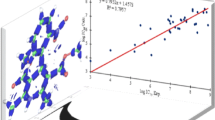Abstract
Purpose. This study was done to explore the relationships of both macroscopic and molecular level physicochemical properties to in-vivo antiarrhythmic activity and interactions with phospholipid membranes for a set of cationic-amphiphilic analogs.
Methods. The 4D-QSAR method, recently developed by Hopfinger and co-workers (1), was employed to establish 3D-QSAR/QSPR models. Molecular dynamics simulations provided the set of conformational ensembles which were analyzed using partial least squares regression in combination with the Genetic Function Approximation algorithm to construct QSAR and QSPR models.
Results. Significant QSAR models for in-vivo antiarrhythmic activity were constructed in which logP (the partition coefficient), and specific grid cell occupancy (spatial) descriptors are the main activity correlates. LogP is the most significant QSAR descriptor. 4D-QSPR models were also developed for two analog-membrane interaction properties, the change in a membrane transition temperature and the ability of the analogs to displace adsorbed Ca2+-ions from phosphatidylserine mono-layers.
Conclusions. Spatial features, represented by grid cell occupancy descriptors, supplement partition coefficient, which is the most important determinant of in-vivo antiarrhythmic activity, to provide a comprehensive model for drug action. The QSPR models are less significant in statistical measures, and limited to interpretation of possible molecular mechanisms of action.
Similar content being viewed by others
REFERENCES
A. J. Hopfinger, S. Wang, J. S. Tokarski, B. Jin, M. Albuquerque, P. Madhav, and C. Duraiswami. J. Am. Chem. Soc., 119:10509–10524 (1997).
R. H. de Jong. Local Anesthetics. Mosby-Year Books Ltd., St. Louis, 1994.
H. Lüllmann, K. Mohr, A. Ziegler, and D. Bieger. Pocket Atlas of Pharmacology. Thieme Medical Publishers, Inc., New York, 1993.
R. S. Sheldon, N. J. Cannon, A. S. Nies, and H. J. Duff. J. Pharmacol. Exp. Ther. 33:327–331 (1988).
L. M. Hondeghem and J. W. Mason. In: B. G. Katzung [ed.], Basic and Clinical Pharmacology, pp 151–168. Appleton & Lange, Norwalk (1987)
G. R. Strichartz. Handbook of Experimental Pharmacology, Vol. 81: Local Anesthetics. Springer Verlag, Berlin, Germany, 1987.
E. Overton. Vierteljahresschrift Naturforsch. Ges. Zürich, 44:88–135 (1899).
A. G. Lee. Nature 262:545–548 (1976).
M. Klingmüller. Ph.D. Thesis, Kiel, Germany, 1990.
S. I. Landmann. Med. Thesis., Kiel, Germany (1996).
S. Girke, K. Mohr, and S. Schrape. Biochem. Pharmacol. 38:2487–2496 (1989).
H. Lüllmann, H. Plösch, and A. Ziegler. Biochem. Pharmacol. 29:2969–2974 (1980).
B. Kursch, H. Löllmann, and K. Mohr. Biochem. Pharmacol. 32:2589–2594 (1983).
R. Hanpft and K. Mohr. Biochim. Biophys. Acta 814:156–162 (1985).
R. Hanpft. Ph.D. Thesis, Kiel, Germany, 1987.
R. D. Cramer, D. E. Patterson, and J. D. Bunce. J. Am. Chem. Soc. 110:5959–5967 (1988).
W. G. Glen, W. J. Dunn III, and D. R. Scott. Tetrahedron Computer Methodology 2:349–376 (1989).
D. Rogers and A. J. Hopfinger. J. Chem. Inf. Comput. Sci. 34:854 (1994).
W. J. Dunn III, and D. Rogers. Genetic partial least-squares in QSAR. In J. Devillers (ed.), Genetic Algorithms in Molecular Modeling, Academic Press, London, 1996, pp. 109–130.
K. Hasegawa, Y. Miyashita, and K. Funatsu. J. Chem. Inf. Comp. Sci. 37:306–310 (1997).
CHEMLAB-II, Revision 11.0. Molecular Simulations Incorporated, San Diego, CA (1993).
J. J. P. Stewart. Mopac 6.0 Manual. Frank J. Seiler Research Laboratory, United States Air Force Academy, CO 80840 (1990).
Molsim Version 3.0. The Chem21 Group, Inc., Lake Forest, IL 60045 (1994).
D. Rogers. WOLF 5.5 Release Notes (1993).
WOLF 6.2 GFA Program. D. Rogers and Molecular Simulations Inc., San Diego, CA (1994).
J. Friedman. Multivariate Adaptive Regression Splines. Technical report No. 102, Laboratory for Computational Statistics, Dept. of Statistics, Stanford University (Nov. 1988).
D. O. Rauls and J. K. Baker. J. Med. Chem. 22:81–86 (1979).
H. Lüllmann, P. Timmermans, and A. Ziegler. Eur. J. Pharmacol. 60:277–285 (1979).
K. Borchardt, D. Heber, M. Klingmüller, K. Mohr, and B. Müller. Biochem. Pharmacol. 42(Suppl.):S61–S65 (1991).
Author information
Authors and Affiliations
Rights and permissions
About this article
Cite this article
Klein, C.D.P., Hopfinger, A.J. Pharmacological Activity and Membrane Interactions of Antiarrhythmics: 4D-QSAR/QSPR Analysis. Pharm Res 15, 303–311 (1998). https://doi.org/10.1023/A:1011983005813
Issue Date:
DOI: https://doi.org/10.1023/A:1011983005813




